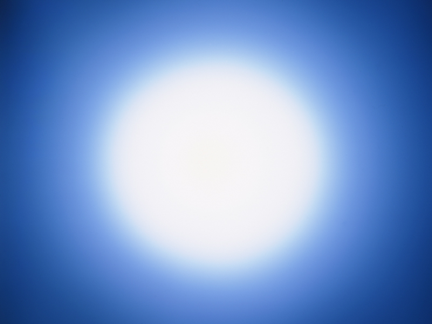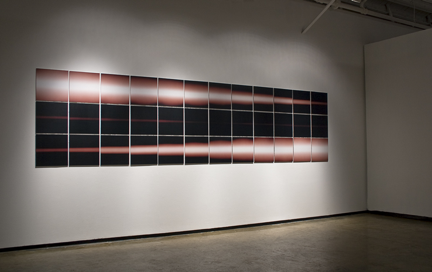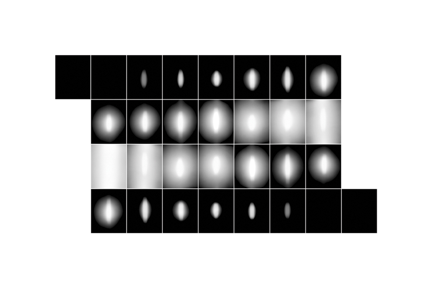RECORDING STELLAR LIGHT
- Published: Tuesday, January 06 2015 02:14

Erika Blumenfeld
Title: Light Recording: Spring 2005 [June 18, 2005]
Date: 2005
Medium: Chromogenic prints, aluminum panels, laminate
Size: 30x40 inches (76.2x101.6 cm)
Description: In Light Recording: Spring 2005, Blumenfeld documented the 93 days between the vernal equinox (March 20, 2005) and the summer solstice (June 21, 2005)—the time in our year that comprises the season known as spring in the northern hemisphere. At the exact moment of civil sunset on March 20th, Blumenfeld recorded onto photosensitive material solely the amount of natural sunlight radiating toward Earth. Using a hand built light-recording device and 4x5 transparency film, the artist repeated this “light recording” process for the subsequent 92 days, exposing sunlight onto separate sheets of film each day at the same time. The resulting series describes the relationship between the Sun and the Earth and their orbital movement that cause our seasons, and depicts the slow increase in sunlight that the northern hemisphere experiences when the sun approaches its northern most point in the sky at summer solstice.
Since I can remember, I’ve been preoccupied with all things relating to the physics of light and the wonder of natural phenomena. The extraordinary events which had to occur in order for us to even have a universe, a planet and a habitable natural environment is an unending source of inspiration to me, and has been the vantage point from which I set forth making art. Initially, these interests led me to investigate the physics of light as both medium and subject in an ongoing series titled Light Recordings. My intent is to explore and document the subtle shifts in atmospheric, astronomic and environmental phenomena, and to record our natural light’s footprint—the direct and reflected light from our nearest star—throughout the daily and seasonal cycles such as dawn and dusk, the solstices and equinoxes, and the waxing and waning of our moon.
I have pursued the effects and characteristics of natural light within the photographic medium for nearly 30 years, but in 1998 I came to a place in my artistic practice where I was inspired to relinquish the traditional techniques and results of photography. This culminated in my developing a method that reduces photography down to its most basic ingredients: light and light sensitive material. Since then, for the Light Recordings work, I have built my own camera-like devices, which record only the natural light itself—what is captured on film is the direct imprint of the quantity and quality of the sunlight or moonlight that was present at the moment the exposure was taken.

Erika Blumenfeld
Title: Light Recording: Total Lunar Eclipse [October 27, 2004]
Medium: Chromogenic prints, aluminum panels, laminate
Size: 36 panels, each 15x15 inches (38.1x38.1 cm); installed: 46x185.5 inches (116.84x471.17 cm)
Installation view: DiverseWorks Art Space, Houston, Texas, Solo Exhibition, 2004
Description: Light Recording: Total Lunar Eclipse [October 27, 2004] is a photo-based installation in which Blumenfeld documented the phenomenon of light without a traditional camera by exposing photographic film directly to light itself through special handmade recording devices. The piece documents the entire four hours of the diminishing and reappearing light of the full moon while it was being eclipsed by the earth’s shadow during the total lunar eclipse of October 27th, 2004. Blumenfeld recorded the light every seven minutes during the eclipse and configured them consecutively from left to right, starting from the top row. This piece was recorded in the Galisteo Basin in New Mexico.
By adopting a somewhat scientific methodology, my artistic practice has led me to follow a rather non-traditional studio practice. My “studio” is almost always outside under the open sky, where the natural light pervades. On occasion, my process has led me to work in collaboration with scientific institutions in order to further my knowledge of a particular field of scientific study, including the McDonald Observatory in far West Texas. In the autumn of 2004, I was invited to Marfa, Texas as the inaugural artist-in-residence at Ballroom Marfa, a non-profit contemporary art space. Upon my arrival, I visited the nearby McDonald Observatory and after dialoguing with them about my project, was granted the rare opportunity to set up my studio on the main peak of the observatory in one of their astronomer’s houses. The location of the observatory is simply stunning—the vast expanse of the high desert landscape extends in every direction atop the mountain peak in an area that is fortunate to have some of the darkest and most pristine night skies in the United States. On my first night working at the observatory I could see the Milky Way more brightly than I had ever seen it before, and it extended across the entire sky from horizon to horizon.
The project at the McDonald Observatory was a pivotal time for me creatively, and during my two-month stay I produced my first video-based installation, titled Moving Light: Lunation 1011. Lunation is the mean time between two successive new moons, and the lunation number is calculated from the first new moon that occurred in 1923. This piece, titled 1011 after the actual lunation cycle recorded, documented the waxing and waning of moonlight over a 30-day period, from new moon to new moon.

Erika Blumenfeld
Title: Moving Light: Lunation 1011, 2004
Medium: Projected Installation (00:03:27, looped, silent, DVD)
Size: Dimensions Variable, Edition of 8
Installation view: DiverseWorks, Houston, Texas, Solo Exhibition, 2004

Erika Blumenfeld
Title: Lunation 1011 (30 Recordings), 2005
Medium: Digital Pigment Ink Print
Size: 24 inches x 30 inches (60.96 x 76.2 cm)
Edition of 30
Published by Santa Fe Editions
Description: Lunation 1011 (30 Recordings) is a print edition based on the video installation Moving Light: Lunation 1011. The piece operates like a calendar of the 30-day lunar cycle that was documented for the video project, where each of the 30 images in the print is one of the still images that comprise the video itself.
Recorded through an altered telescope and self-built recording devices, my intent was to capture the varying nightly intensities of moonlight onto handheld photographic film. The images portray not only the changing quantity of moonlight in its nightly phase, but also the presence of my own hand which, in holding each piece of film over the long two-minute exposures, moved slightly from my own heartbeat and my body’s slight natural motion while standing. The 30 days of exposures were then sequenced and animated to produce a moving account of the lunar cycle.
The night sky at the McDonald observatory remains for me the most incredible view of the universe that I have experienced thus far, and my time there under that starry night has inspired much of the artwork that I have done since—it inspired new works in the Light Recordings series over the last 10 years (much of which has yet to be exhibited), it was the seed for my imagining The Polar Project and my journey to Antarctica (which I’ll discuss in part 2), it broadened my interest in nature advocacy that culminated in my Bioluminescence and Wildfire series (which I’ll discuss in part 3), and it cultivated my passion for dark night sky advocacy that led to my newest project Sky Scrolls (which I’ll discuss in part 4).
 Erika Blumenfeld (b. 1971, USA) is an internationally exhibiting transdisciplinary artist and Guggenheim Fellow with a BFA from Parsons School of Design and an MSc from University College London. Since 1998, Blumenfeld’s work has been concerned with the wonder of natural phenomena and our relationship with our natural environment. Approaching her work like an ecological archivist, Blumenfeld has chronicled a range of subjects, including atmospheric and astronomic phenomena, bioluminescent organisms, the polar regions, wildfires, and the natural night sky. In each series, the artist investigates the simple beauty and complex predicament of our environment and ecology, working with scientists and research institutions such as the Scripps Institution for Oceanography, the McDonald Observatory, the South African National Antarctic Program and NASA.
Erika Blumenfeld (b. 1971, USA) is an internationally exhibiting transdisciplinary artist and Guggenheim Fellow with a BFA from Parsons School of Design and an MSc from University College London. Since 1998, Blumenfeld’s work has been concerned with the wonder of natural phenomena and our relationship with our natural environment. Approaching her work like an ecological archivist, Blumenfeld has chronicled a range of subjects, including atmospheric and astronomic phenomena, bioluminescent organisms, the polar regions, wildfires, and the natural night sky. In each series, the artist investigates the simple beauty and complex predicament of our environment and ecology, working with scientists and research institutions such as the Scripps Institution for Oceanography, the McDonald Observatory, the South African National Antarctic Program and NASA.
Blumenfeld has exhibited widely in the US and abroad, including Albright Knox Art Gallery (Buffalo, New York), TATE Modern (London), Fondation EDF Espace Electra (Paris), and Kunstnernes Hus (Oslo, Norway). She has received grants from Creative Capital Foundation and The Polaroid Collections, and artist-in-residences with Cape Farewell (Scotland), with SANAP/ITASC (Antarctica), and Ballroom Marfa (Texas). Blumenfeld has been featured in Art In America, ARTnews and more than a half dozen books, including The Polaroid Book (Taschen 2005 & 2008), Arte da Antarctica (Goethe-Institut, 2009) and Art and Ecology Now (Thames & Hudson, 2014). Her works are in the permanent collections of Albright-Knox Art Gallery, Lannan Foundation, Houston Museum of Fine Arts, New Mexico Museum of Fine Arts, Scottsdale Museum of Contemporary Art, and University of Texas.
For more information, please visit the artist’s website: www.erikablumenfeld.com








Comments